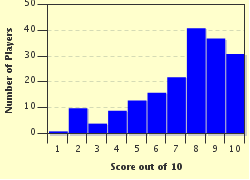Quiz Answer Key and Fun Facts
1. Which of the following letters/groups of letters would you NOT expect to see written underneath a line of music indicating dynamics?
2. A sharp (A#) is equivalent to which of these notes?
3. What is the order of sharps?
4. Which of these would you expect to find at the start of a piece of music?
5. What is a ledger line?
6. How many horizontal lines normally appear on the stave?
7. There is no black key on a piano (or keyboard) between which of the following notes?
8. What does ">" mean?
9. Which of these notes does not exist?
10. In the treble clef, the notes in the spaces (between the lines of the stave) are ___. (Fill in the blank)
Source: Author
AdamM7
This quiz was reviewed by FunTrivia editor
ertrum before going online.
Any errors found in FunTrivia content are routinely corrected through our feedback system.

